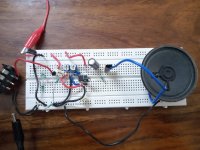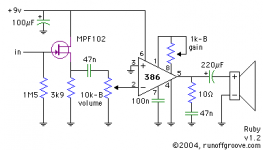I am trying to build the popular Ruby LM386 amplifier circuit on a breadboard, but cannot get it to work correctly.
The output is extremely low and distorted. And the gain control potentiometer does not appear to change anything.
The JFET input stage is also significantly attenuating the signal, as the sound is noticeably louder if I connect the guitar input straight to the LM386, bypassing the JFET. (But still pretty low compared to a pre-made LM386 module)
I have used all the same value components as in the schematic, expect for the JFET which is a 2N5484.
Would appreciate any inputs on how to troubleshoot the circuit. A picture of my breadboard layout is attached.
The output is extremely low and distorted. And the gain control potentiometer does not appear to change anything.
The JFET input stage is also significantly attenuating the signal, as the sound is noticeably louder if I connect the guitar input straight to the LM386, bypassing the JFET. (But still pretty low compared to a pre-made LM386 module)
I have used all the same value components as in the schematic, expect for the JFET which is a 2N5484.
Would appreciate any inputs on how to troubleshoot the circuit. A picture of my breadboard layout is attached.
Attachments
Fets are not as interchangeable as bjts. Are the specs the same? Whats the voltage at the drain of the fet?
Last edited:
Just noticed that circuit looks wrong. The +input is connected directly to ground. Its usually set to 1/2 of V+. I could be wrong, not familiar with that chip. Check the fet first.
Last edited:
LM386 is NOT an Op Amp, it was designed to be used as shown.
Drain is connected to +V ; 9V on this case.
@ MadCarburetor
Please measure Fet sourc voltage and 386 pin 5 , which "should" be 1/2 +V so about 4.5V DC
Your amp may very well be oscillating (which you won´t hear ) which makes for a dirty distorted output sound.
Chipamps have high gain and high bandwidth so you must be careful with grounding and decoupling.
You mean the source.Whats the voltage at the drain of the fet?
Drain is connected to +V ; 9V on this case.
@ MadCarburetor
Please measure Fet sourc voltage and 386 pin 5 , which "should" be 1/2 +V so about 4.5V DC
Your amp may very well be oscillating (which you won´t hear ) which makes for a dirty distorted output sound.
Chipamps have high gain and high bandwidth so you must be careful with grounding and decoupling.
hi, if you touch the input capacitor after the fet buffer do you get any noise? if so check the jfet pinouts maybe you put it wrong with the pins backwards
Voltages are as follows:
G: 0
S: ~150mv
D: ~9V
Pin 5 of LM386: ~4.9V
Double checked the JFET pinout, it is correctly is connected.
I also noticed that the Ruby Amp schematic does not have a capacitor between pins 1 and 8 with the trim pot like the data-sheet circuit. How is the gain control supposed to work without it in this case?
G: 0
S: ~150mv
D: ~9V
Pin 5 of LM386: ~4.9V
Double checked the JFET pinout, it is correctly is connected.
I also noticed that the Ruby Amp schematic does not have a capacitor between pins 1 and 8 with the trim pot like the data-sheet circuit. How is the gain control supposed to work without it in this case?
LM386 is NOT an Op Amp, it was designed to be used as shown.
You mean the source.
Drain is connected to +V ; 9V on this case.
@ MadCarburetor
Please measure Fet sourc voltage and 386 pin 5 , which "should" be 1/2 +V so about 4.5V DC
Your amp may very well be oscillating (which you won´t hear ) which makes for a dirty distorted output sound.
Chipamps have high gain and high bandwidth so you must be careful with grounding and decoupling.
^ this, add a .1 uF capacitor on the +V pin closest as possible and short it to ground see if this does something
....schematic does not have a capacitor between pins 1 and 8 with the trim pot like the data-sheet circuit. How is the gain control supposed to work without it in this case?
It works fine. All the way to DC.
We don't actually hear DC. So we often wish to NOT amplify to DC. The cap blocks sub-sonic gain increase.
But the Ruby is cheap and simple. DC gain is not a big deal.
Be Neat and direct!! Haywire construction is sure to leak output to input and, like a PA mike, howl (maybe inaudible).
Voltages! What power supply? Does it hold a steady voltage when you play, or is it crapping-out when ask to work hard?
Your '47n' capacitors look like they might be polystyrene. At that physical size they can only be 47 pico-Farads, not nano-Farads. That would be 1000 times smaller in value.
You will also want to find either a less-conductive 2N5484, or select a much higher value resistor in place of the 3k9. Maybe try 15k or 22k for starters -- you'll want at least a volt or two on the Source, with no signal, to properly buffer a guitar output.
Cheers
You will also want to find either a less-conductive 2N5484, or select a much higher value resistor in place of the 3k9. Maybe try 15k or 22k for starters -- you'll want at least a volt or two on the Source, with no signal, to properly buffer a guitar output.
Cheers
Oh, at that size they can still be 47n , onñy by some lowish voltge, say 100V
FWIW I have and use 22n x 160V, about that size, and slightly fatter 220n x 63V , so it´s not physically impossible.
FWIW I have and use 22n x 160V, about that size, and slightly fatter 220n x 63V , so it´s not physically impossible.
small OT
@ JMFAhey
Look what I've seen at minute 17:00
Tango with Rodolfo Mederos in Buenos Aires | A Different Way (2007) - YouTube
🙂
@ JMFAhey
Look what I've seen at minute 17:00
Tango with Rodolfo Mederos in Buenos Aires | A Different Way (2007) - YouTube
🙂
Hang a scope (AC coupled) on the source of the JFET (3K9 resistor) and see if the signal voltage follows the input signal cleanly. There will be a DC offset. If no scope's available, then look at it with an AC DVM instead. In & source signal voltages should be nearly the same. The DVM will not tell you if the waveform's distorted, while a scope view will show gross distortion. With no input signal, DC voltage at that point should sit ideally at about 1/2 the supply voltage.
- Home
- Live Sound
- Instruments and Amps
- Help with Ruby Amp

